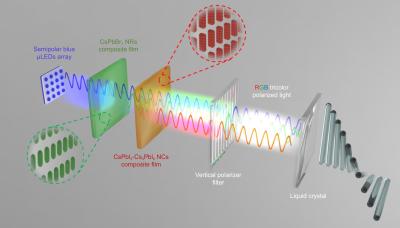Researchers from China's Xiamen University, Innovation Laboratory for Sciences and Technologies of Energy Materials of Fujian Province (IKKEM), Yang Ming Chiao Tung University and Hon Hai Research Institute have reported a self-polarizing RGB device utilizing semipolar micro-LEDs and perovskite-in-polymer films aimed at improving backlight applications.
Structure of an LCD based on semipolar blue μLEDs excite anisotropic perovskite NCs as backlight. Image from Opto-Electronic Advances
In backlighting systems for LCDs, conventional red, green, and blue (RGB) light sources that lack polarization properties can result in a significant optical loss of up to 50% when passing through a polarizer. To address this inefficiency and optimize energy utilization, the scientists developed a high-performance device designed for RGB polarized emissions. The device uses an array of semipolar blue µLEDs with inherent polarization capabilities, coupled with mechanically stretched films of green-emitting CsPbBr3 nanorods and red-emitting CsPbI3-Cs4PbI6 hybrid nanocrystals.
The team's device uses halide perovskite nanocrystals, known for their exceptional photoluminescence and color purity, within anisotropic structures to achieve polarized emission without significant light loss. This approach not only addresses the inefficiencies of current polarizing techniques but also circumvents the challenges associated with synthesizing red-emitting perovskite nanostructures, which are often plagued by morphological instability.
Led by Associate Professor Tingzhu Wu, the team engineered a device architecture incorporating blue semipolar micro-LEDs, which inherently emit polarized light. These LEDs serve as the excitation source for color-conversion layers made from stretched composite films of green and red perovskite nanocrystals. These films exhibit strong polarized emission thanks to their aligned wire structures, further enhanced by encapsulation in a high-dielectric constant material for the red components.
This device design has achieved polarized light emission across the full RGB spectrum with high efficiency and stability, marking a critical advancement in display technology. The green and red perovskite layers maintain their polarization properties under stretch, offering a practical solution for scalable luminescence applications. Furthermore, the device demonstrates a wide color gamut, exceeding standard benchmarks with 137.2% of NTSC and 102.5% of Rec. 2020, alongside impressive Degree of Linear Polarization (DOLP) values across all three colors.
The technology's compatibility with existing industrial manufacturing processes for large-scale production of stretched polymer films indicates its potential for rapid integration into commercial products. With its ability to maximize energy utilization in LCD backlights without the need for additional UV filtering, this self-polarizing RGB device represents a step towards more efficient and vibrant displays.




